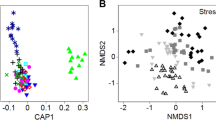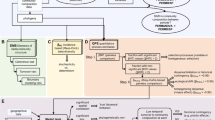Abstract
Spatial heterogeneity significantly enhances biodiversity, representing one of the ecology's most enduring paradigms. However, many studies have found decreasing, humped, and neutral correlations between spatial heterogeneity and biodiversity (heterogeneity–diversity relationships, HDR). These findings have pushed this widely accepted theory back into controversy. Microbial HDR research has lagged compared to that of plants and animals. Nevertheless, microbes have features that add a temporal-scale perspective to HDR research that is critical to understanding patterns of HDR. In this study, 157 microcosms with different types spatial heterogeneity were set up to map the HDR of microorganisms and their temporal dynamics using high-throughput sequencing techniques. The results show that the following: 1. Spatial heterogeneity can significantly alter microbial diversity in microcosmic systems. Changes in microbial diversity, in turn, lead to changes in environmental conditions. These changes caused microorganisms to exhibit increasing, decreasing, humped, U-shaped, and neutral HDR patterns. 2. The emergence of HDR patterns is characterized by temporal dynamics. Additionally, the HDR patterns generated by spatial structural and compositional heterogeneity exhibit inconsistent emergence times. These results suggest that the temporal dynamics of HDR may be one of the reasons for the coexistence of multiple patterns in previous studies. The feedback regulation between spatial heterogeneity–biodiversity–environmental conditions is an essential reason for the temporally dynamics of HDR patterns. All future ecological studies should pay attention to the temporal dynamic patterns of ecological factors.







Similar content being viewed by others
References
Allouche O, Kalyuzhny M, Moreno-Rueda G et al (2012) Area-heterogeneity tradeoff and the diversity of ecological communities. Proc Natl Acad Sci U S A 109:17495–17500. https://doi.org/10.1073/PNAS.1208652109/-/DCSUPPLEMENTAL/SAPP.PDF
Bar-Massada A (2015) Immigration rates and species niche characteristics affect the relationship between species richness and habitat heterogeneity in modeled meta-communities. PeerJ. https://doi.org/10.7717/PEERJ.832
Ben-Hur E, Kadmon R (2020a) Heterogeneity-diversity relationships in sessile organisms: a unified framework. Ecol Lett 23:193–207. https://doi.org/10.1111/ELE.13418
Ben-Hur E, Kadmon R (2020b) An experimental test of the area-heterogeneity tradeoff. Proc Natl Acad Sci U S A 117:4815–4822. https://doi.org/10.1073/PNAS.1911540117
Benton TG, Vickery JA, Wilson JD (2003) Farmland biodiversity: is habitat heterogeneity the key? Trends Ecol Evol 18:182–188. https://doi.org/10.1016/S0169-5347(03)00011-9
Bokulich NA, Subramanian S, Faith JJ et al (2013) Quality-filtering vastly improves diversity estimates from Illumina amplicon sequencing. Nat Methods 10:57–59. https://doi.org/10.1038/NMETH.2276
Bokulich NA, Kaehler BD, Rideout JR et al (2018) Optimizing taxonomic classification of marker-gene amplicon sequences with QIIME 2’s q2-feature-classifier plugin. Microbiome 6:90. https://doi.org/10.1186/s40168-018-0470-z
Bolyen E, Rideout JR, Dillon MR et al (2019) Reproducible, interactive, scalable and extensible microbiome data science using QIIME 2. Nat Biotechnol 37:852–857. https://doi.org/10.1038/S41587-019-0209-9
Callahan BJ, McMurdie PJ, Rosen MJ et al (2016) DADA2: high-resolution sample inference from Illumina amplicon data. Nat Methods 13:581–583. https://doi.org/10.1038/nmeth.3869
Carvalho JC, Cardoso P, Borges PAV et al (2013) Measuring fractions of beta diversity and their relationships to nestedness: a theoretical and empirical comparison of novel approaches. Oikos 122:825–834. https://doi.org/10.1111/J.1600-0706.2012.20980.X
Chase JM, Gooriah L, May F et al (2019) A framework for disentangling ecological mechanisms underlying the island species-area relationship. Front Biogeogr 11:e40844. https://doi.org/10.21425/F5FBG40844
De Souza Júnior MB, Ferreira FF, De Oliveira VM (2014) Effects of the spatial heterogeneity on the diversity of ecosystems with resource competition. Physica A 393:312–319. https://doi.org/10.1016/J.PHYSA.2013.08.045
Deng W, Liu L-L, Yu G-B et al (2022) Testing the resource hypothesis of species–area relationships: extinction cannot work alone. Microorganisms 10:1993. https://doi.org/10.3390/MICROORGANISMS10101993
Deng W, Li N, Zhang C-Z et al (2023a) Extinction drives a discontinuous temporal pattern of species–area relationships in a microbial microcosm system. Sci Rep 13:3720. https://doi.org/10.1038/s41598-023-30685-x
Deng W, Yu G-B, Yang X-Y, Xiao W (2023b) Testing the passive sampling hypothesis: the role of dispersal in shaping microbial species-area relationship. Front Microbiol. https://doi.org/10.3389/fmicb.2023.1093695
Dickey JR, Swenie RA, Turner SC et al (2021) The utility of macroecological rules for microbial biogeography. Front Ecol Evol 9:633155. https://doi.org/10.3389/FEVO.2021.633155/BIBTEX
Dixon P (2003) VEGAN, a package of R functions for community ecology. J Veg Sci 14:927–930. https://doi.org/10.1111/j.1654-1103.2003.tb02228.x
Fossum S, Crooke E, Skarstad K (2007) Organization of sister origins and replisomes during multifork DNA replication in Escherichia coli. EMBO J 26:4514–4522. https://doi.org/10.1038/SJ.EMBOJ.7601871
Gazol A, Tamme R, Price JN et al (2013) A negative heterogeneity–diversity relationship found in experimental grassland communities. Oecologia 173:545–555. https://doi.org/10.1007/S00442-013-2623-X
Heidrich L, Bae S, Levick S et al (2020) Heterogeneity–diversity relationships differ between and within trophic levels in temperate forests. Nat Ecol Evolut 4:1204–1212. https://doi.org/10.1038/s41559-020-1245-z
Kadmon R, Allouche O (2007) Integrating the effects of area, isolation, and habitat heterogeneity on species diversity: a unification of island biogeography and niche theory. Am Nat 170:443–454. https://doi.org/10.1086/519853
Laanisto L, Tamme R, Hiiesalu I et al (2013) Microfragmentation concept explains non-positive environmental heterogeneity-diversity relationships. Oecologia 171:217–226. https://doi.org/10.1007/S00442-012-2398-5
Lê S, Josse J, Husson F (2008) FactoMineR: an R package for multivariate analysis. J Stat Softw 25:1–18. https://doi.org/10.18637/JSS.V025.I01
Locey KJ, Muscarella ME, Larsen ML et al (2020) Dormancy dampens the microbial distance–decay relationship. Philos Trans R Soc B Biol Sci 375:20190243. https://doi.org/10.1098/rstb.2019.0243
Lu Y-X, Deng W, Qi F-L et al (2023) Revived amplicon sequence variants monitoring in closed systems identifies more dormant microorganisms. Microorganisms 11:757. https://doi.org/10.3390/MICROORGANISMS11030757
Miao BG, Peng YQ, Yang DR et al (2022) Diversity begets diversity: low resource heterogeneity reduces the diversity of nut-nesting ants in rubber plantations. Insect Sci 29:932–941. https://doi.org/10.1111/1744-7917.12964
Neilson JW, Califf K, Cardona C et al (2017) Significant impacts of increasing aridity on the arid soil microbiome. mSystems 2:16. https://doi.org/10.1128/MSYSTEMS.00195-16/SUPPL_FILE/SYS003172106ST5.PDF
Prosser JI, Bohannan BJM, Curtis TP et al (2007) The role of ecological theory in microbial ecology. Nat Rev Microbiol 5:384–392. https://doi.org/10.1038/nrmicro1643
R Core Team (2023) R: a language and environment for statistical computing
Rainey PB, Buckling A, Kassen R, Travisano M (2000) The emergence and maintenance of diversity: insights from experimental bacterial populations. Trends Ecol Evol 15:243–247. https://doi.org/10.1016/S0169-5347(00)01871-1
Stein A, Kreft H (2015) Terminology and quantification of environmental heterogeneity in species-richness research. Biol Rev 90:815–836. https://doi.org/10.1111/BRV.12135
Stein A, Gerstner K, Kreft H (2014) Environmental heterogeneity as a universal driver of species richness across taxa, biomes and spatial scales. Ecol Lett 17:866–880
Thomsen MS, Altieri AH, Angelini C et al (2022) Heterogeneity within and among co-occurring foundation species increases biodiversity. Nat Commun 13:581. https://doi.org/10.1038/S41467-022-28194-Y
Turner MG, Gardner RH (2015) Landscape metrics. Landscape ecology in theory and practice. Springer, New York, pp 97–142
Williams CB (1964) Patterns in the balance of nature and related problems in quantitative ecology. In: Theoretical and experimental biology. Academic Press, New York, p 324
Yilmaz P, Parfrey LW, Yarza P et al (2014) The SILVA and “all-species living tree project (LTP)” taxonomic frameworks. Nucleic Acids Res 42:643–648. https://doi.org/10.1093/NAR/GKT1209
Acknowledgements
The authors thank Yu Guo-bin, Yuan Cai-Lian, Zhong Xin-Yuan, Cheng Yi-Ting, and Lu Ya-Xian for their contributions in laboratory research.
Funding
This work was funded by the National Nature Science Foundation of China (32371557) and the Second Tibetan Plateau Scientific Expedition and Research Program (2019QZKK2002).
Author information
Authors and Affiliations
Contributions
WD, RS, and WX conceived and designed the experiments. WD, NEB, FLQ, and XYY performed the experiments. WD and WX analyzed the data. WD and WX wrote the manuscript; other authors provided editorial advice.
Corresponding authors
Ethics declarations
Conflict of interest
The authors have no relevant financial or non-financial interests to disclose.
Data availability
All data produced from this study are provided in this manuscript.
Additional information
Communicated by Melinda D. Smith.
Rights and permissions
Springer Nature or its licensor (e.g. a society or other partner) holds exclusive rights to this article under a publishing agreement with the author(s) or other rightsholder(s); author self-archiving of the accepted manuscript version of this article is solely governed by the terms of such publishing agreement and applicable law.
About this article
Cite this article
Deng, W., Bai, NE., Qi, FL. et al. Temporal dynamics of the microbial heterogeneity–diversity relationship in microcosmic systems. Oecologia 204, 35–46 (2024). https://doi.org/10.1007/s00442-023-05484-w
Received:
Accepted:
Published:
Issue Date:
DOI: https://doi.org/10.1007/s00442-023-05484-w




